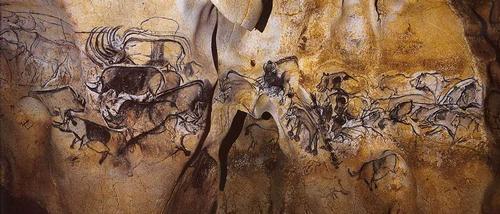21 Apr 2015
France spends €56m recreating prehistoric cave paintings for new attraction
BY Tom Anstey

The French government has spent €56m (US$60m, £40.2m) recreating an exact replica of a cave discovered in 1994 containing a huge collection of prehistoric paintings of horses, mammoths and rhinos – among the oldest documented pieces on earth.
The works – preserved thanks to a rock fall roughly 23,000 years ago – were quickly closed off to the public after their discovery on the basis that something as simple as breathing could erode the unique prehistoric gallery. As a result the French government, along with a group of engineers, artists and scientists, have been working since 2012 to create an identical replica just 2km (1.2m) away from the original site.
Created from a 3D scan of the cave by Perazio Engineering, the new cave covers an area of 3,000sq m (32,300sq ft) with 8,200sq m (88,300sq ft) of developed surfaces (including floors, walls and ceilings). Architecture firms Fabre-Speller and Atelier3A worked on the masterplan for the development, while Franck Neau operated as landscape architect for the cave, co-ordinating with construction firm Campenon Bernard Regions and Vinci Construction France on the building work.
During development, original techniques were used to create more than 1,000 paintings, hand prints and carvings, with the designers even going as far as to recreate the stalagmites and stalactites from the original site as well as the humid smell and cool temperatures associated with the original cave.
To recreate the wall art, design companies Arc et Os, Création Graphique and Déco-Diffusion were selected to recreate wall panels for the cave, with engineering firms Freyssinet, Cofex and AAB tasked with installing the recreated cave walls. French company Phénomènes recreated the cave’s geological features and wildlife design specialists Cossima Productions and Dasplet recreated animal bones found in the cave.
Work on the development started in Q3 of 2012 and was completed in March 2015. Of the €55m investment, the Rhône-Alpes regional government and the Department of the Ardeche each gave €14.7m (US$15.8m, £10.5m) in funding, while the French State contributed €12.2m (US$13m, £8.8m), Europe gave €9.9m (US$10.6m, £7.1m) and €3.5m (US$3.6m, £2.5m) came from heritage body Rossillon Kléber.
The replica Grotte Chauvet-Pont d’Arc – named after its discoverer Jean-Marie Chauvet – was unveiled by French President François Hollande on 17 April ahead of its public opening at the end of the month. Grotte Chauvet is the largest cave replica ever built worldwide, ten times bigger than its nearest counterpart. The original paintings are believed to be around 30,000 to 37,000 years old, which, at the time of their discovery, were the oldest cave paintings known on earth.
On opening, the Rhône-Alpes regional government and the Department of the Ardeche who manage the site are hoping to draw about 300,000 visitors on an annual basis. The cave is one of France’s most important historical relics and was recognised by UNESCO as a World Heritage Site in June 2014.
For more on 3D scanning of heritage sites, check out the upcoming Q2 2015 edition of Attractions Management.
Close Window